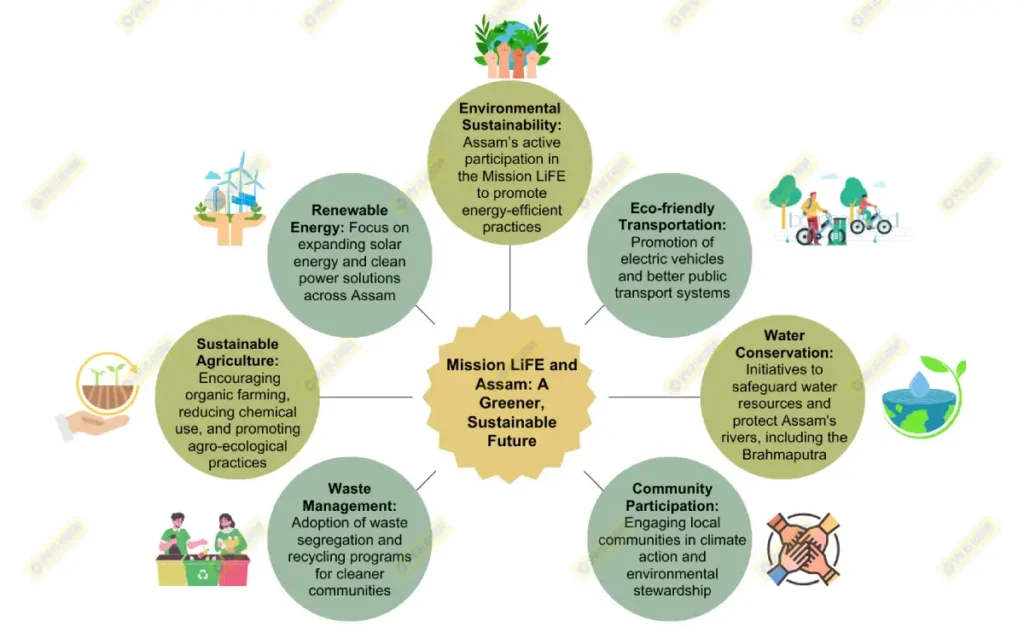Mission LiFE (Lifestyle for Environment) is a global initiative launched by Prime Minister Narendra Modi during COP26 in 2021 and officially unveiled in 2022 at Gujarat’s Kevadia. It is rooted in the philosophy of “Pro-Planet People” (P3) and aims to foster sustainable lifestyles by encouraging individuals, communities, and governments to adopt environmentally conscious behaviors. LiFE advocates for a bottom-up approach to addressing climate change impacts by shifting from wasteful consumption to resource-efficient lifestyles, thus complementing broader climate mitigation and adaptation strategies.
The mission aligns with UN’s SDG 12 (Responsible Consumption and Production) and aims to reduce global greenhouse gas emissions by fostering behavioral change. The UNEP Emissions Gap Report (2022) highlights that individual and household actions could reduce up to 20% of global emissions by 2050, underscoring the relevance of LiFE.

How Mission LiFE Plans to Address Climate Change Impacts
1. Promoting Behavioral Change:
Encourages citizens to shift from unsustainable consumption patterns to conscious resource utilization, addressing excessive emissions associated with lifestyle habits.
2. Decentralized Climate Action:
Shifts climate responsibility from governments alone to individual and community-level efforts, ensuring wide-scale participation.
3. Reducing Carbon Footprint:
Focuses on small, collective actions like conserving energy, reducing waste, and sustainable mobility to minimize individual and societal carbon footprints.
4. Mainstreaming Sustainable Practices:
Integrates environment-friendly actions into daily life, creating a multiplier effect to amplify global climate mitigation efforts.
5. Public Awareness Campaigns:
Drives grassroots awareness about climate impacts, using schools, local governance bodies, and media to embed sustainable practices into society.

Example: During the LiFE Global Call for Ideas and Papers, innovative ideas for sustainable practices from youth and civil society were highlighted, showcasing its inclusivity.
Four LiFE Actions to Reduce Carbon Footprint
- Energy Conservation at Home
○ Replace incandescent bulbs with LED lights, turn off appliances when not in use, and use energy-efficient devices.
○ Impact: Reduces household electricity consumption and contributes to lowering fossil fuel-based power demand. - Sustainable Transportation
○ Use public transport, carpooling, or non-motorized transport like cycling for daily commuting.
○ Impact: Reduces emissions from vehicles, which contribute nearly 10% of India’s total greenhouse gas emissions. - Minimizing Food Waste
○ Plan meals, store food efficiently, and compost organic waste.
○ Impact: Reduces methane emissions from landfills and ensures optimal resource utilization in food production. - Water Conservation Practices
○ Adopt practices like rainwater harvesting, repair leaking taps, and use water-efficient fixtures.
○ Impact: Conserves fresh water, a resource under stress due to climate change and over-extraction.
Mission LiFE exemplifies a shift from the “blame-game” narrative of climate action to shared responsibility and underscores the role of individuals in global sustainability efforts. By integrating simple, actionable practices into daily life, it seeks to create a pro-planet ethos that complements technological and policy interventions. LiFE’s success could serve as a blueprint for global climate action, transforming climate commitments into tangible, grassroots solutions. As individuals, adopting LiFE actions can amplify collective efforts to address the climate crisis, fostering a sustainable future for generations to come.











